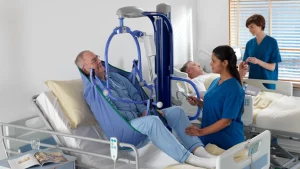As the global healthcare landscape continues to evolve, empowering individuals with mobility challenges to navigate their surroundings independently becomes increasingly vital. User training for transfer lift systems plays a pivotal role in this pursuit, fostering confidence, overcoming fear, and promoting autonomy. By focusing on user training, we can unlock the full potential of transfer lift systems, leading to true independence.
Key Takeaways
- User training for transfer lift systems empowers individuals with mobility impairments to regain autonomy and independence in their daily lives.
- Thorough training fosters confidence, reduces anxiety and fear, and promotes the safe and efficient use of transfer lifts.
- Mastery of transfer lift operations enables individuals to navigate their surroundings confidently, enhancing their overall user experience and safety.
- Proper training is crucial for individuals with mobility impairments, as it develops skills and knowledge, leading to increased independence and self-reliance.
- By providing a supportive environment and addressing concerns, user training helps overcome fear and uncertainty, leading to a sense of control and independence.
Building Confidence Through Training
Through focused instruction and hands-on practice, user training for transfer lift systems empowers individuals to develop the skills and self-assurance necessary to operate these devices with confidence. By mastering the safe and efficient use of transfer lifts, users can overcome uncertainty and gain the independence they desire. This thorough training fosters a sense of belonging and confidence.
Overcoming Fear of Transfer Lifts
As users become more confident in their abilities, they are better equipped to confront and overcome the fear of transfer lifts that may have initially held them back. User training for transfer lift systems provides a supportive environment where individuals can address their concerns and develop a deeper understanding of the equipment, leading to increased confidence and independence.
User Training for Safe Operations
Properly administering user training for transfer lift systems is essential for ensuring safe operations, as it enables users to develop the necessary skills and knowledge to handle the equipment correctly. This training instills confidence, reduces anxiety and fear, and empowers users to operate the system independently, promoting a sense of autonomy and self-reliance.
Enhancing User Experience and Safety
Thorough Training for users of transfer lift systems not only fosters a safe operating environment but also greatly enhances the overall user experience, leading to increased satisfaction and reduced stress levels. By empowering users with the knowledge and skills to operate the system confidently, Training for users of transfer lift systems promotes a sense of control and independence, ultimately contributing to a more positive and safe experience.
Independence Through Proper Training
By acquiring the necessary skills and knowledge to operate transfer lift systems, users can regain a sense of autonomy and independence in their daily lives, which is particularly important for individuals with mobility impairments. Through user training for transfer lift systems, individuals can confidently navigate their surroundings, fostering a sense of self-reliance and empowerment.
Frequently Asked Questions
How Often Should User Training for Transfer Lift Systems Be Refreshed or Updated?
Regular refreshers are essential to maintaining proficiency in user training for transfer lift systems, ideally every 6-12 months, or as dictated by changes in equipment, procedures, or user needs, to guarantee continued safety and confidence.
Are User Training Programs for Transfer Lift Systems Accessible for Users With Disabilities?
User training programs for transfer lift systems should be designed to be accessible and inclusive for users with disabilities, incorporating adaptive technologies and accommodations to promote equal participation and independence.
Can User Training for Transfer Lift Systems Be Conducted Online or Remotely?
Yes, user training for transfer lift systems can be conducted online or remotely, offering flexibility and convenience for users, especially those with mobility limitations, while still ensuring they receive thorough and engaging instruction.
What Is the Ideal Duration of a User Training Session for Transfer Lift Systems?
The ideal duration of a user training session for transfer lift systems typically ranges from 30 minutes to 2 hours, depending on the complexity of the system and the user’s prior experience.
Are User Training Programs for Transfer Lift Systems Standardized Across Manufacturers?
While there is no universal standard for user training programs among transfer lift system manufacturers, many industry leaders follow similar guidelines and best practices, ensuring a consistent level of quality and safety in their training offerings.
Conclusion
Effective user training for transfer lift systems is vital in promoting autonomy and independence among individuals with mobility challenges. By providing thorough instruction and hands-on practice, users can overcome fear and uncertainty, and develop the skills and confidence necessary for safe and efficient operation. This, in turn, leads to enhanced user experience, reduced stress levels, and a greater sense of control and independence. Ultimately, user training is essential for empowering individuals to navigate their surroundings with confidence and ease.
Also Read: Personal Addiction Recovery Strategies


